What is OTN?
OTN—or Optical Transport Network—is a telecommunications industry standard protocol— defined in various ITU Recommendations, such as G.709 and G.798—that provides an efficient way to transport, switch, and multiplex different services onto high-capacity wavelengths across the optical network. Today, network providers rely on OTN-enabled technology in their optical networks to gain benefits that include increased resiliency, simplified operations, enhanced Service-Level Agreements (SLA), extended reach with Forward Error Correction (FEC), and the ability to efficiently maximize wavelength fill as well as guaranteed end-to-end service delivery.
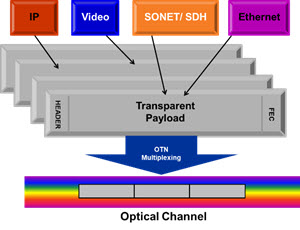
OTN is commonly called a ‘digital wrapper’ as it wraps each client/service transparently into a container for transport across optical networks, preserving the client’s native structure, timing information, and management information. The enhanced multiplexing capability of OTN allows different traffic types, including IP, Ethernet, storage, digital video, and SONET/SDH, to be carried over an OTN framing structure—a key reason for the adoption of OTN.
Since its inception in 2001, OTN has continued to evolve beyond a simple SONET/SDH wrapper. In fact, OTN has been optimized to support Ethernet—today’s most popular client service—from 1GE to 400GE. OTN-enabled technology often underpins next-generation optical networks with its ability to support flexible packet technologies that include new Ethernet interfaces, Multi-Protocol Label Switching (MPLS), Segment Routing, and Time Sensitive Networking (TSN) to name a few. To date, OTN technology has been extensively deployed in networks across the globe, with increasing scope across a wide spectrum of applications. Hundreds of thousands of OTN ports have been deployed and are carrying mission-critical traffic from the edge into the metro and core of the network, as well as in submarine applications.
OTN information structure
The OTN wrapper is made up of several components in a hierarchy as depicted in Figure 1.
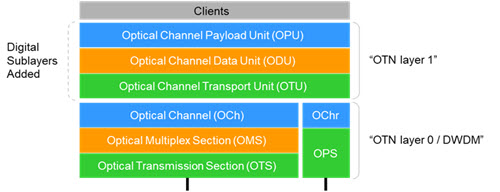
Figure 1: OTN Information Structure
The Optical Transport Module (OTM) is the information structure transported across the optical interface. It has two parts: a digital structure and an optical structure. The Optical Channel Payload Unit (OPU) contains the payload frames. The payload area of the OPU structure is comprised of end-user services such as IP, Ethernet, or any other protocol. The OPU overhead is associated with the mapping of client data into the payload area. The Optical Channel Data Unit (ODU) contains the OPU overhead and payload area, plus additional overhead such as BIP8, GCC1/2, Tandem Connection Monitoring (TCM), and so on. The ODU represents the OTN path service within an OTN network.
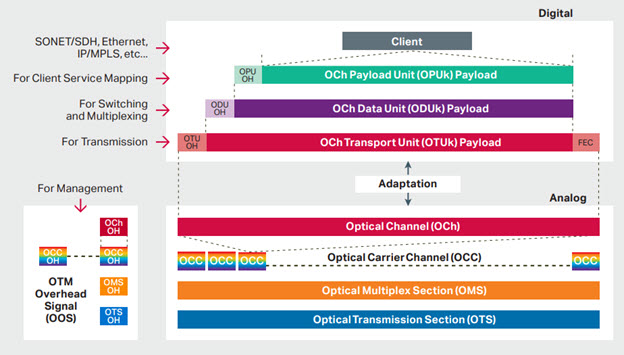
Figure 2: The Optical Transport Module (OTM) is the information structure
The Optical Transport Unit (OTU) contains the ODU overhead and payload, provides the section-level overhead (such as BIP8), and supports General Communication Channel (GCC) bytes for overhead communication between network nodes.
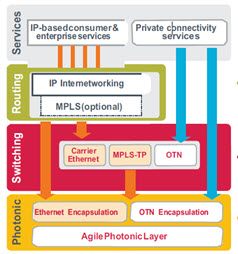 OTN technology in optical networking
OTN technology in optical networking
As shown in Figure 3, OTN technology is used in various ways within an optical network. OTN mapping or encapsulation is used to provide high-bandwidth agile photonic connections. For example, today’s coherent modems leverage OTN mapping to transport client service(s) over a high-capacity coherent wave. Transponders that are widely deployed today use OTN to map a client to a Dense Wavelength Division Multiplexing (DWDM) channel.
OTN is also widely deployed among networks leveraging module-based or central fabric-based OTN hardware. An OTN muxponder multiplexes lower speed clients onto a DWDM channel within a hardware module or compact platform, enabling cost-effective point-to-point connectivity. Muxponders aggregate and groom lower rate services and are used in compact DCI platforms today to transport multiple 100GE/400GE services. It is important to note that even packet optimized technologies like 400ZR and OpenZR+ are based on OTN structures that are optimized for Ethernet only clients.

Larger networks in the metro and core consisting of many nodes that are interconnected together can use an OTN centralized fabric, which again multiplexes (or grooms) lower speed clients onto a DWDM channel. However, it is by way of a back-plane cross connect or fabric.
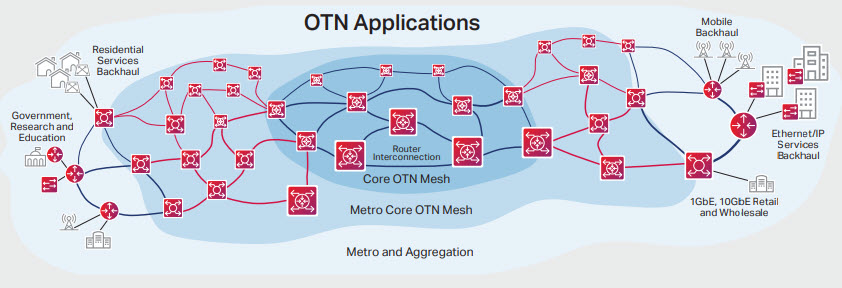
This enables highly flexible, scalable and on-demand any-to-any connectivity over the network. The result is the ability to maximize fiber capacity with efficient utilization of high-capacity next-generation coherent wavelengths. This solution can also be coupled with an OTN control plane to deliver increased reliability for enhanced SLA leveraging flexible protection/restoration options. It is important to note that some providers are deploying hybrid packet and OTN switching, enabling flexible deployments with any degree of packet and/or OTN switching.
Key operator benefits
Today, operators gain a competitive edge from the significant advantages offered by OTN, including improved performance with Forward Error Correction (FEC), simplified operations, faster service turn-up, maximized efficiencies, and differentiated services. Operators can thus leverage next-gen technologies over a programmable optical infrastructure to quickly respond to today’s unpredictable bandwidth requirements. Let’s explore some of these key advantages in more detail.
Improved performance with FEC. A key advantage of OTN is that it defines an out-of-band FEC scheme applied to the signal before transmission. FEC dramatically improves tolerance to network impairments present in high-capacity transmissions, correcting and detecting errors in the optical link. FEC is used to significantly increase system margin for a given Bit Error Rate (BER) and signal power, which allows longer spans in the network. This enables providers to extend the distance between optical repeaters, which helps reduce both capital and operational expenses while simplifying the network topography with the ability to skip amplifier sites.
Simplified operations and enhanced SLAs. OTN provides service assurance and faster troubleshooting capabilities that include topology tracing, error detection, and fault isolation/correlation.
Built-in real-time latency measurement. Complying with maximum latency SLAs is an important requirement in many applications. Latency measurements are native to OTN and can be used to ensure SLA compliance.
End-to-end service monitoring. OTN includes traffic monitoring solutions native to the protocol— with features such as TCM—which allows end-to-end service monitoring across multiple domains as shown in Figure 4.
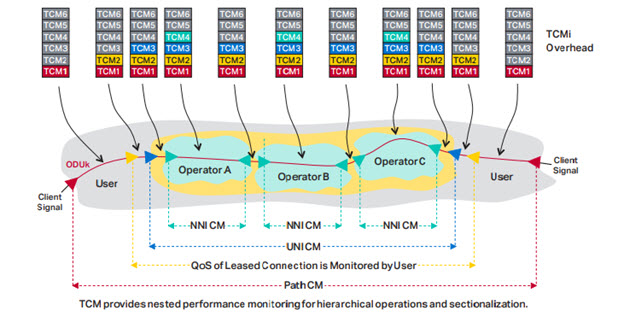
Figure 4: End-to-end service monitoring with Tandem Connection Monitoring (TCM)
TCM offers enhanced sub-network operations that define up to six levels of performance monitoring, enabling improved operations and the ability to efficiently deliver differentiated SLAs across the sub-network segments.
Faster service turn-up. The decoupling of the client from the DWDM line allows separation of service turn-up from that of adding capacity to the DWDM network. This means that new services can be added quickly, simply by selecting available line capacity between the start and end nodes (A and Z) within the meshed network. This differs significantly from using a more traditional transponder-based architecture approach that requires dedicating a new wavelength between two points that need bandwidth. When the fill levels reach planning thresholds, additional line capacity can be added as needed. Fast service turn-up is an important competitive differentiator and is a key building block for enabling a more dynamic, on-demand network that enables operators to rapidly respond to service requests to meet changing customer expectations and unpredictable traffic requirements.
Maximize network efficiency. OTN offers the ability to map a flexible range of clients onto a DWDM wavelength and allows multiple clients to share the same optical network. This capability allows network providers to run their DWDM links as efficiently as possible with no stranded bandwidth, thereby maximizing network efficiencies. The emergence of ODUflex traffic containers enables the highest degree of network bandwidth optimization, particularly when transporting sub-rated Ethernet/packet services. With a packet/OTN centralized fabric that supports ODUflex containers, providers can precisely adjust the size of the OTN container in 1.25G increments to more efficiently match the service that is being transported.
Differentiated service offerings. By combining OTN switching and the L1 (OTN) control plane, operators can benefit from enhanced programmability, whereby services can be established, protected, and restored according to specific SLAs and policies. Having a packet/OTN mesh-based network with ubiquitous OTN switching in conjunction with a control plane allows for fast restoration of services, as OTN switches can be rapidly reconfigured—faster than ROADMs.
Future-proof the network. OTN helps future-proof networks from technology changes, enabling operators to support:
- New line rates: OTN supports rates beyond 100G (B100G) with the new, flexible nx100G format called OTUCn and FlexO. The OTN switching capabilities can migrate client services to the new line interfaces. This flexibility enables transport of both current and future client signals over high-capacity wavelengths, such as 800G, which requires an OTUC8.
- New technologies: OTN allows the re-use of client cards/ports as new line cards or modulations are introduced and deployed. This means that existing line cards can remain in place without the need for new fiber patches.
- New clients: OTN offers built-in support for new client interfaces such as 400GbE and FlexE, where the OTN switching capability can groom the new client services into a single or group of line interfaces.
Ciena’s 6500 Family of Packet-Optical Platforms leverage the latest technology innovation across L0 to L3 to enable a programmable infrastructure that can scale and respond on demand to changing customer requirements. With the 6500 Family, operators can deploy OTN blade-based transponders and muxponders as well as agnostic packet/OTN fabric-based hardware, scaling to 24Tb/s per shelf. Combined with intelligent OTN control plane capabilities, the 6500 Family efficiently supports applications from the edge to the core and across the ocean.


